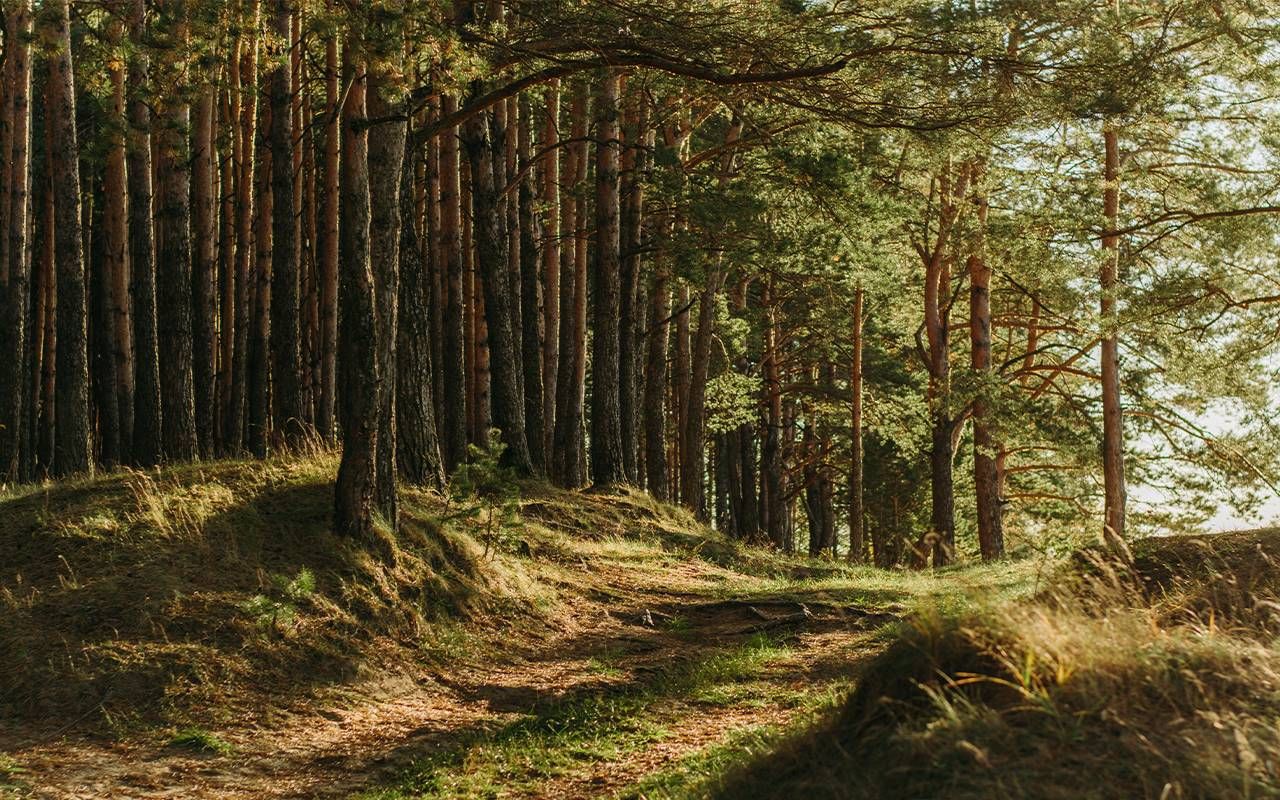Giving the Gift of Land
Conservation-based estate planning keeps land natural and intact for future generations
Millions of people in the United States love the woodlands they own and want to preserve their land as part of their legacy but aren't sure how to go about it. Foresters and environmentalists worry that these privately owned forests — and the wildlife habitat and watersheds they compose — are being destroyed when property is developed.
Conservation-based estate planning is one solution.

Few people think of preserving land as part of an estate. Instead, what comes to mind is selling real property for development and dividing the proceeds among heirs. But it doesn't have to be that way.
Conservation-based estate planning offers creative options. By mixing and matching a set of legal and tax tools, landowners can protect all or part of the land they love, accommodate multiple heirs with differing interests and needs and reduce their taxes.
How to Make It Work
Because land and family circumstances are unique there's no cookie-cutter way of accomplishing these goals. Reports by the University of Massachusetts Amherst called "Protecting Your Legacy" and Oregon State University's "Ties to the Land" include useful examples of approaches landowners took.
Few people think of preserving land as part of an estate.
For the Browns, 29 family members across three generations owned a 500-acre Western Massachusetts farmstead that they all loved and used for vacations. With such complicated ownership, setting up a family trust was their answer to keeping the land intact.
They developed a mission statement and bylaws to guide land use and specify dues for taxes and maintenance. This arrangement allows the family to continue enjoying the land while sharing the responsibilities of ownership.
Three Properties, No Heirs
The Davids own property in three states and have no heirs. They want to keep their forests and farmland resilient and healthy into the future. While they're still ironing out the details for their 120-acre southern pine forest in Florida and 280-acre Montana farm, they plan to put the land into the hands of people they know and trust as stewards to care for it.
For their 155-acre Idaho mixed conifer forest where they live, the Davids worked with a land trust to place a conservation easement on the property. The easement prohibits subdividing the forest and limits development in perpetuity. They plan to sell their house, so the easement exempts five acres around it so future owners can build anew if they choose.
The Simplest Way
Conservation-based estate planning can be complex and costly, requiring a variety of specialized professionals. But if few heirs are involved, relationships are good and there's little disagreement about the property's use, a detailed will may suffice to preserve the land.
Attaching a legacy letter describing your land's meaning and value to you, what you enjoy about it and how you'd like it to be used can be worthwhile. While such a letter has no legal force, it can help your survivors understand why the land matters so much to you and help guide their decisions.
Finding a Partner
National, state, local and tribal government agencies and land trusts are the primary organizations to help protect your land. Some federal programs, such as the U.S. Department of Agriculture's wetlands and carbon sequestration easements, are administered by state natural resource agencies.
"Each property is unique, and the land trust and the landowner must have shared goals for how the land can and will be protected."
These agencies, whose names vary by state, may run their own conservation programs based on specific types of lands they want to protect. They may offer technical or financial assistance and landowner workshops.
Land trusts are nonprofit organizations that conserve land by purchasing it, accepting donations or partnering with landowners through conservation easements. Some, like the Nature Conservancy and American Farmland Trust, are national organizations. Many others serve particular geographical regions, including urban areas.
Each land trust has specific criteria for the type of land they're interested in protecting. Usually this is based on the property's ecological, agricultural or recreational value or its historical significance. Consequently, not all land will find an organization to accept it, and you'll have to do some searching.
Research Recommended
To find a potential match, start by reading land trusts' philosophies and conservation missions and their views about land and land management.
"Each property is unique and the land trust and the landowner must have shared goals for how the land can and will be protected," said MaryKay O'Donnell of the Land Trust Alliance.
Accredited member organizations are listed on the Find a Land Trust page of the Alliance website. Most states have an organization similar to the Missouri Land Trust Coalition, where you can look for regional and local land trusts.
Searching through the 465 trusts certified by the Land Trust Accreditation Commission is a good way to start looking for a match. But, since only about one-third are accredited and each has specific criteria for the types of land and locales in which they work, you may need to consider non-accredited trusts. Even so, accreditation standards can help you know what to look for.
O'Donnell also recommends reviewing the land trust's financials to make sure they have adequate resources to manage the land in perpetuity. She suggests asking to review conservation plans, strategic plans and the history of inspecting and defending the land or monitoring and defending conservation easements. Check Charity Navigator or Guidestar to make sure they're financially solid and transparent in how they operate.
Living with an Easement
Government agencies or land trusts can issue a conservation easement, also sometimes called a conservation restriction or conservation agreement. These easements prohibit or limit residential and commercial development on land covered by the easement. Additionally, because they typically lower the assessed value of the land, easements often reduce taxes.
"Most easements, and all that are tax deductible, are perpetual in nature."
"Most easements, and all that are tax deductible, are perpetual in nature," said Larry Levin, co-chair of the Missouri Land Trust Coalition, "so a landowner is making a decision that could impact their land forever."
However, the landowner and the land trust or agency negotiate the terms of the easement and there's a lot of flexibility. For example, easements need not allow public access, although some families have created public conservation areas named after the family or an ancestor.
Like many woodland landowners, the Baileys reduced property taxes on their 87 acres of Massachusetts woods and fields by actively stewarding their land through a state-approved forest management plan. But as they aged and the neighborhood around them developed, they opted to permanently protect their land.
Cut Taxes, Not Trees
They placed an easement on 60 acres, donated 22 acres to a land trust to create a publicly accessible conservation area and reserved five acres that included their house and barns. Some states offer income tax credits or other incentives for keeping land undeveloped.
By conserving their land in stages over a period of years as the land trust advised, the Baileys benefitted from Massachusetts's income tax credit, while continuing to manage and use the land as they always had.
While there are usually tax benefits associated with conservation easements, there are costs too. Occasionally a piece of land is so important to an organization's conservation goals that it will cover costs and pay the landowner for the easement.
Prepare to Pay Something
More commonly, landowners pay for appraisals, natural resource assessments, title work and other easement preparation activities as well as an upfront or annual administrative fee to help manage and defend the land in the future.
Credit for charitable contributions or other tax breaks can sometimes offset these costs. Tax laws and conservation options can vary by state and even by county, so it's essential to consult estate and tax professionals — ideally those with nonprofit and land conservation experience.
There are many more ways to conserve land, including farms, orchards, ranches, working forests, prairies, wetlands, even community gardens and cities' open space. "Protecting Your Legacy" and "Ties to the Land" provide good overviews and case examples. Regardless of which state you live in, these publications can kickstart your planning.
Educate Yourself and Hire Pros
Then review the websites of a few land trusts and talk with a representative of your state's conservation agency. If you find a land trust near you, consider setting up a time to talk with the people who run it. Beware that the process may become complicated quickly.
Mistakes can result in IRS audits, unnecessary taxes or tying up your land in ways you later regret. So if you want to move forward, call in some pros.
"Try not to get overwhelmed — the hardest step is often the first one."
O'Donnell at the Land Trust Alliance suggests that prospective donors contact professional organizations to find qualified accountants, appraisers, lawyers, planners and other experts. The Alliance's affiliate member directory includes some; land trusts may have lists, though they won't give recommendations.
Each should have relevant experience: accountants or other tax professionals knowledgeable about nonprofits, real estate lawyers familiar with land trusts, estate attorneys with land conservation experience, appraisers well-versed in conservation easements, licensed foresters and skilled surveyors.
The best advice may be found in "Protecting Your Legacy: "Try not to get overwhelmed — the hardest step is often the first one."


